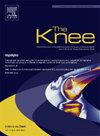Patellar tilt calculation utilizing artificial intelligence on CT knee imaging
IF 1.6
4区 医学
Q3 ORTHOPEDICS
引用次数: 0
Abstract
Background
In the diagnosis of patellar instability, three-dimensional (3D) imaging enables measurement of a wide range of metrics. However, measuring these metrics can be time-consuming and prone to error due to conducting 2D measurements on 3D objects. This study aims to measure patellar tilt in 3D and automate it by utilizing a commercial AI algorithm for landmark placement.
Methods
CT-scans of 30 patients with at least two dislocation events and 30 controls without patellofemoral disease were acquired. Patellar tilt was measured using three different methods: the established method, and by calculating the angle between 3D-landmarks placed by either a human rater or an AI algorithm. Correlations between the three measurements were calculated using interclass correlation coefficients, and differences with a Kruskal-Wallis test. Significant differences of means between patients and controls were calculated using Mann-Whitney U tests. Significance was assumed at 0.05 adjusted with the Bonferroni method.
Results
No significant differences (overall: p = 0.10, patients: 0.51, controls: 0.79) between methods were found. Predicted ICC between the methods ranged from 0.86 to 0.90 with a 95% confidence interval of 0.77–0.94. Differences between patients and controls were significant (p < 0.001) for all three methods.
Conclusion
The study offers an alternative 3D approach for calculating patellar tilt comparable to traditional, manual measurements. Furthermore, this analysis offers evidence that a commercially available software can identify the necessary anatomical landmarks for patellar tilt calculation, offering a potential pathway to increased automation of surgical decision-making metrics.
膝关节CT图像人工智能髌骨倾斜计算
背景:在髌骨不稳定的诊断中,三维(3D)成像可以测量广泛的指标。然而,由于在3D对象上进行2D测量,测量这些指标可能非常耗时并且容易出错。本研究旨在3D测量髌骨倾斜,并利用商业人工智能算法自动进行地标放置。方法对30例至少有两次脱位事件的患者和30例没有髌骨股疾病的对照组进行ct扫描。髌骨倾斜是通过三种不同的方法来测量的:一种是既定的方法,另一种是通过计算由人类评分者或人工智能算法放置的3d地标之间的角度。使用类间相关系数计算三个测量值之间的相关性,并使用Kruskal-Wallis检验计算差异。采用Mann-Whitney U检验计算患者与对照组的均值显著差异。经Bonferroni方法调整后,假设显著性为0.05。结果两种方法间无显著差异(总p = 0.10,患者p = 0.51,对照组p = 0.79)。方法间的预测ICC范围为0.86 ~ 0.90,95%置信区间为0.77 ~ 0.94。患者与对照组之间差异显著(p <;0.001)。结论:该研究为计算髌骨倾斜提供了可替代的3D方法,可与传统的手动测量相媲美。此外,该分析提供的证据表明,商业上可用的软件可以识别髌骨倾斜计算所需的解剖标志,为提高手术决策指标的自动化提供了潜在途径。
本文章由计算机程序翻译,如有差异,请以英文原文为准。
求助全文
约1分钟内获得全文
求助全文
来源期刊

Knee
医学-外科
CiteScore
3.80
自引率
5.30%
发文量
171
审稿时长
6 months
期刊介绍:
The Knee is an international journal publishing studies on the clinical treatment and fundamental biomechanical characteristics of this joint. The aim of the journal is to provide a vehicle relevant to surgeons, biomedical engineers, imaging specialists, materials scientists, rehabilitation personnel and all those with an interest in the knee.
The topics covered include, but are not limited to:
• Anatomy, physiology, morphology and biochemistry;
• Biomechanical studies;
• Advances in the development of prosthetic, orthotic and augmentation devices;
• Imaging and diagnostic techniques;
• Pathology;
• Trauma;
• Surgery;
• Rehabilitation.
 求助内容:
求助内容: 应助结果提醒方式:
应助结果提醒方式:


